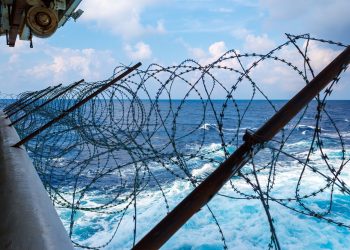A marine pilot, also called maritime pilot, harbor pilot, port pilot, ship pilot, or simply pilot, is a mariner who maneuvers ships through dangerous or congested waters, such as harbors or river mouths. They are navigational experts possessing knowledge of the particular waterway, licensed or authorised by a recognised pilotage authority.
When a ship needs to enter or leave a harbor, marine pilots are sent aboard via a small pilot boat to safely navigate the vessel through the local waterways. This operation is known as pilot transfer arrangements.
Unlike the captain and crewmembers who travel onboard the ship, marine pilots are usually stationed at the ports. While due to the nature of the work, many pilots have previously worked as a ship’s officer or master.
As Canaveral Pilots Association explains:
“Marine pilots are responsible for the safety of the vessel which they are navigating, and also with the protection of the state waters, harbors, ports, the environment, life and property, including effects that ships transiting a harbor may have on other ships moored at the docks and any impact on port facilities”.
Why can’t the sea captain be the pilot?
One thing is for sure, there is no comparison between those two, as they both provide an essential and unique service to the shipping industry.
However, the answer is simple. A marine pilot only controls ships when they’re in crowded harbors or other confined waters. Although the captain knows the ship and crew well, along with the pilot’s assistance and expertise in a particular waterway, they result to the safely navigation of the vessel.
“Ship’s masters cannot be expected to be fully conversant with the special navigational and regulatory requirements of an area”.
…European Maritime Pilots’ Association stated.
To put it straightforward, marine pilots offer local communications knowledge, which is necessary to work with local services such as tugs and linesmen.
During the pilotage, masters still retain command of their vessel, however, the direction of the movement of the vessel is turned over to the pilot in order to transit the local channels, waterways etc.
“Captains and pilots relationship is an intriguing balance of mutual trust and respect, largely unwritten, which provides an unrivalled level of safety in a society that expects, and receives, the highest of standards from the shipping industry”.
… European Maritime Pilots’ Association added.
Thus, the collaboration among the pilot and the master is necessary to avoid any hazard.
Marine pilotage working environment
Being a marine pilot requires to board vessels at sea. Although is a risky and demanding process, since the pilot needs to be reasonably fit and comfortable in working on the water and at height. In addition, pilot ladder arrangements have long been considered to be unsafe. According to IMO, one of the problems encountered by pilots is that of getting on board the ship, particularly when the weather is bad, or the ship is very large.
[smlsubform prepend=”GET THE SAFETY4SEA IN YOUR INBOX!” showname=false emailtxt=”” emailholder=”Enter your email address” showsubmit=true submittxt=”Submit” jsthanks=false thankyou=”Thank you for subscribing to our mailing list”]
Therefore, requirements to make this easier are included in Chapter V of the SOLAS Convention, and have also formed the subject of IMO resolutions covering performance standards for mechanical pilot hoists (A.275(VIII); arrangements for embarking and disembarking pilots in very large ships (A.426(XI); and pilot transfer arrangements (A.667(16)). An MSC Circular (MSC/Circ.568/Rev.1) covers required boarding arrangements for pilots.
Speaking of pilot ladder arrangements, a recent safety campaign for 2020, by the international community of pilots IMPA, revealed that 12.11% of arrangements were noncompliant with combination ladders, while pilot ladders having the most defects by both number and percentage.
As the report states:
“Many of the common issues found with securing of pilot ladders are steps taken by crews as a way to work around constraints imposed by deck cargo, loading or other prevailing circumstances”.
Regulations on marine pilotage
Back in 1968, the International Maritime Organization (IMO) formally recognized the importance of employing qualified pilots in approaches to ports and other areas where specialized local knowledge is required.
Namely, IMO adopted Assembly resolution A.159 (ES.IV) Recommendation on Pilotage.
To better explain, the resolution recommends Governments organize pilotage services where they would be likely to prove more effective than other measures and to define the ships and classes of ships for which employment of a pilot would be mandatory.
Marine pilots training and certification
It was back in 2003, when the IMO officially adopted resolution A.960(23) Recommendations on training and certification and operational procedures for maritime pilots other than deep-sea pilots, which includes Recommendation on Training and Certification of Maritime Pilots other than Deep sea Pilots and Recommendation on Operational Procedures for Maritime Pilots other than Deep sea Pilots.
Did you know?
- Marine pilots are also referred as maritime pilots, harbor pilots, port pilots, ship pilots, or simply pilots.
- There is a global association for pilots known as “International Maritime Pilots’ Assosiation” which was launched in June 1970, in an effort to promote effective safety outcomes in pilotage as an essential public service. Currently, it represents 8.360 marine pilot members in 51 countries.
- In English law, Section 742 of the Merchant Shipping Act 1894 defines a pilot as “any person not belonging to a ship who has the conduct thereof.”
































































What is the procedure of becoming a maritime pilot
when did the navy start requiring harbour pilots, what year? the reason i ask is because i heard that in the 70’s some navy captains would pull their ddg’s pierside without pilots or tugs.